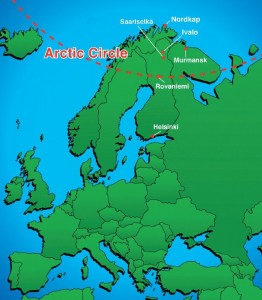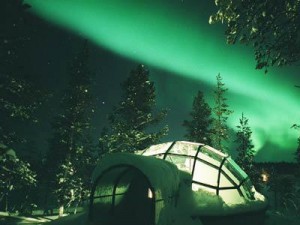Aurora Borealis, or The Northern Lights are an atmospheric phenomenon created high in the Earths Atmosphere. The collision of gases with oxygen combine to produce a myriad of coloured lights, streaking and waving across the nights sky.
Green is the most commonly produced colour, tinging the snow and onyx background an eerie green. Despite being a nightly occurrence, the Northern Lights are most visible at certain times, and predicting when they will appear will greatly increase you chances of seeing them.
So when is the best time of year?
Knowing when to see the Northern Lights is easy in theory – the further north you are, the longer the viewing time frame. It ranges from the beginning of September until mid April, during the perpetual twilight of the very North.
More popular tourist destinations for viewing, which are often a little more south, recommend that you visit after the first new moon in September until the last new moon in March.
Nights in September are very dark in areas near the Arctic Circle, the show is even more beautiful than in areas further south.
Be well prepared for cold trips, as winter never sees the sun rise, and the constant darkness ensures that the temperature is consistently below freezing. All locations also have the similarity of strong bitter winds, so wrap up well with a windproof jacket, balaclava and thermals.
Expect it to be very cold night with temperatures reaching -15 to -25 most of the time.
At what time are the lights clearest?
The lights have the potential to be seen anytime between dusk and sunrise, which is long during winter. In some locations this can be as early as 4pm, but generally dusk arrives at 6pm. Peak hours however, are between 10am and 11pm and can extend until just after midnight.
It is essential that the night sky is cloudless in order to see the lights. Towards the end of winter, beginning of spring is most likely cloudless, as the weather greatly improves. The autumn winter period often see heavy snowfall so there is a greater chance of clouds.
It is not uncommon for tour groups to drive around looking for a break in the clouds to witness the aurora.
Lighting is perhaps the second most influential factor in the northern lights. It is necessary to travel far from city lights as they obscure viewing. Think of how city lights prevent you from seeing the stars. The best time to go is during a new moon, when the moon is at its smallest, and therefore producing less light.
During a full moon, chances of seeing the Northern lights reduce dramatically as there is too much glare, so checking the moon phases before you plan your trip is a good idea!
Factor weather into your travel plans, as Scandinavia is often cloudy at the beginning of winter so it is best to wait until later in the season to go.
Keep an eye on solar activity, the more active the sun, the brighter the lights. This is all related to the sun cycle that influences our weather patterns, and right now we are in the midst of a very active period of solar maximum.
From now until 2015 will be the best viewing time for another 10 years, so get planning a trip to Scandinavia to see the Northern Lights!



